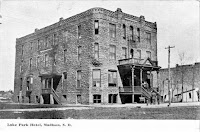MDL has just finished its run of Mr. Gale Pifer's four-part series on the arts in Madison. Pifer ends the series on a hopeful note in Friday's paper, offering a list of various groups, volunteers, and professional artists keeping the arts alive in the community. However, the series' overall message is that that noble corps of cultural crusaders -- Jim Swanson's writing group, middle school art teacher
Ginny Freitag, wildlife artist
John Green, arts promoter Beth Knuths, artist-author couple Allan and Eve Fisher, and our favorite local artist-entrepreneurs,
Michael and Reina Hope -- are fighting a losing battle in the face of waning fiscal support for music and theater from our school district and the community at large.
Of course, the rhetorical structure of Pifer's opus makes sense. He offers a hard-hitting assessment of the problem but constantly intersperses reminders that Madison has a long tradition of great arts programs -- Bill Ireland's legendary high school band (and Jim Glanzer's profound influence on a full generation of middle school hornblowers and drum-pounders), lively theater from both SDSU's Prairie Rep and a community acting company started by Senator Mundt himself, a downtown art gallery with free art lessons for kids. These reminders of past arts achievements work in tandem with Pifer's optimistic ending to tell us that Madison can support a vigorous arts scene. We all just need to be willing to jump in and help.
So why don't we? Why do we accept our duly elected school board's prioritization of football (
ten coaches for grades 7-12) over music (from what I read in the paper, one instructor for 6-12 band, one for 6-12 chorus, and one for elementary music)? How did we lose the ambition to stage community theater productions? Why did we let the city's need for more office space crowd out the old Firehouse Gallery without finding a way to ensure the city would help create a new community arts center?
Now I suppose the best supporter of the arts wouldn't sit around and ask these questions; he'd just get up and do make some art. And trust me: in the coming weeks, this artist will be out in the
studio making more paintings. But this artist is also a blogger, with a compelling desire to sit around and chew on such questions (and maybe provoke you, loyal readers, to come up with some answers, if not solutions).
A conversation Friday evening with a former student, now just a friend, inclines me to wonder if economics plays role. This friend just moved to Madison and has been struggling to find a decent job. The want ads mostly seek wait staff and bartenders.
Gehl has some welding positions that I hear pay $13 an hour, but even that doesn't go much farther than paying the basic bills for a small family. (My roughly $20 an hour barely does that, and I buy 90% of my teacher clothes at Goodwill.) Maybe people just can't afford a night out at a show.
But as far as I know, wages in Madison and South Dakota have never been very high. I'm not sure today's Madisonites are making significantly more or less than our predecessors. I'm not even willing to say wealth is more concentrated. We still have a large laboring and farming class that doesn't have a lot of spare money, but we also have an apparently growing class that can fuel a small housing boom on Lake Madison with some half- and three-quarter-million (do I hear one million?) McMansions. I see no clear indication that the town or county as a whole is poorer and thus less financially able to support the arts than it was in the 1960s or 1980s.
Maybe the regional wealth is relatively the same, but people are having to work harder to get it. Perhaps as we have shifted to the two-income household model, people find themselves having to work more hours just to keep up with their increasing taxes, tech bills (cell phone, wireless Internet, satellite TV -- all monthly budget expenses that hardly existed 20 years ago and haven't been offset by other immediate household savings), and daycare costs (another budget line item that has ballooned compared to previous decades' household budgets). If husband and wife are both out working all day to pay the bills, and if the kids are hustled through school and day care and other activities all day, by suppertime, the family may just want to spend time relaxing together at the homestead instead of running around town to arts events.
That explanation may not cover the issue entirely, either, since we still have hundreds of people regularly finding time to pack the gym for basketball games. Maybe we come back to priorities: in the old days (and I welcome my senior readers to correct any rose-colored glasses viewing of a false past here), maybe folks had time to see a couple games a week and catch a show or even volunteer to perform on stage or do some fundraising for the band.
I don't have a clear answer on this question. But something has clearly changed. Madison used to support more arts activities. It could support a similar number of arts programs now, but somehow the collective will has not formed to make that happen. Is the economy stopping us, or is it something else? Some mysterious demographic shift that has pushed creative types away? An influx of yahoos? Some shift in our education system that has promoted a devaluation of the arts? The answer to that question is the only thing missing from Gale Pifer's otherwise thorough and welcome discussion of the state of the arts in Madison.
